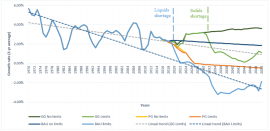Jaime Nieto, Óscar Carpintero, Luis J. Miguel, Ignacio de Blas, from UVA, partner of MEDEAS project, have recently published an article on “Macroeconomic modelling under energy constraints: Global low carbon transition scenarios” in Energy Policy. The article describes the MEDEAS' Economy module and evaluates three different policy scenarios/assumptions, including the option of disabling the energy constraints for each of them. The results are focused on the macroeconomic and emissions impacts, as well as on the importance of accounting with direct and indirect energy carriers through Input-Output Analysis.
Integrated Assessment Models provide a framework to study sustainability transitions and their economic impacts. Models seldom consider energy constraints, taking supply availability for granted and thus suggesting a mere change in the energy mix from non-renewables to renewables. In order to address these limitations, a macro-economic module within a broader system dynamics model (MEDEAS) has been developed. The model has been run for the whole world from 1995 to 2050 under three different scenarios: Business as Usual (BAU), considering no further transition policies and keeping current trends; Green Growth (GG), undertaking the low-carbon transition according to the Paris Agreement set of policies and with high GDP growth standards; and Post-Growth (PG), testing the sustainability transition under a GDP non-growth/degrowth approach. The results reveal the conflict between economic growth, climate policy and the sustainability of resources. Whereas a BAU approach would not even be an option to achieve climate goals, a GG view would not only face the downsizing of economic output, but neither would it be able to achieve the 2 °C objective. The success of the PG approach in meeting emissions objectives suggests a redirection from economic growth policies to an industrial policy that incorporates efficiency and redistribution.
The complete article can be found here.

